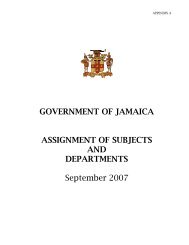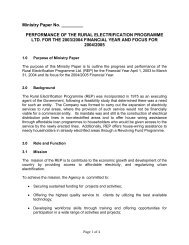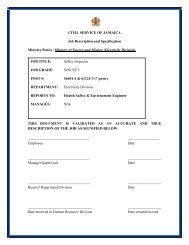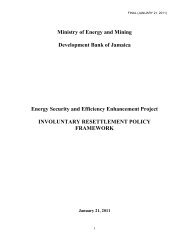Jamaica Biofuels Report - Ministry of Energy
Jamaica Biofuels Report - Ministry of Energy
Jamaica Biofuels Report - Ministry of Energy
You also want an ePaper? Increase the reach of your titles
YUMPU automatically turns print PDFs into web optimized ePapers that Google loves.
Total sugarcane consumption: 393,000 tonnes per year (including leaves and tops tosupplement bagasse fuel)Crop period: 270 days/yrHarvest method: Manual (70%) and mechanized (30%)(2) Fermentation and DistillationHydrous ethanol production: 33,750,000 Liters/yr(3) Cogeneration PlantPower production: 7.4 MWPower for export: 3.1 MWElectricity exported: 26,000 MWh/yrBoiler pressure: 67 barFuel used:o Bagasse: 131,000 tonnes/yro Methane from biogas: 1.5 million cubic meters/yrOverviewThis pilot builds on plans by the Duckenfield Estate to increase sugarcane production bycultivating more land and improving yields. Currently, the mill counts on cane fromapproximately 3,000 captive hectares (Jones and Golden estates) and purchases fromindependent farmers, who cultivate an additional 500 hectares. Yields range from 44.5tonnes/ha on small farms to 86.5 tonnes/ha on the Jones Estate. The plan is to expand thecultivated area to 4,500 total hectares, and assuming that the owners are able to achieveaverage yields <strong>of</strong> 82 tonnes/ha, the mill will have available 370,000 tonnes <strong>of</strong> cane per year toprocess. That amount corresponds with the capacity <strong>of</strong> a recently constructed facility thatproduces ethanol from cane juice in the Philippines and can thus serve as a model for a similarinstallation at Duckenfield.The prospect evaluated here begins with the assumption that without an investment inethanol, cane production and processing at Duckenfield would expand, reaching 37,000 tonnesper year <strong>of</strong> crystalline sugar and 3,700 tonnes per year <strong>of</strong> molasses. The pilot project would addethanol fermentation and distillation equipment, upgrade the boiler house to generatesufficient high pressure steam, add turbine generators to supply electric power for on-siterequirements and 3.1 MW for export to the grid, and install an anaerobic digester to treatwastes and produce methane as a fuel supplement. The resulting capability would permit themill to sell 33.75 million liters <strong>of</strong> ethanol and 26,000 megawatt hours <strong>of</strong> electricity per year.Assuming the cost <strong>of</strong> cane and other operation and maintenance costs would be the same,whether the mill produced sugar or ethanol, the project amounts to a capital investment to beamortized by the higher revenues that energy products could command relative to sugar.92










